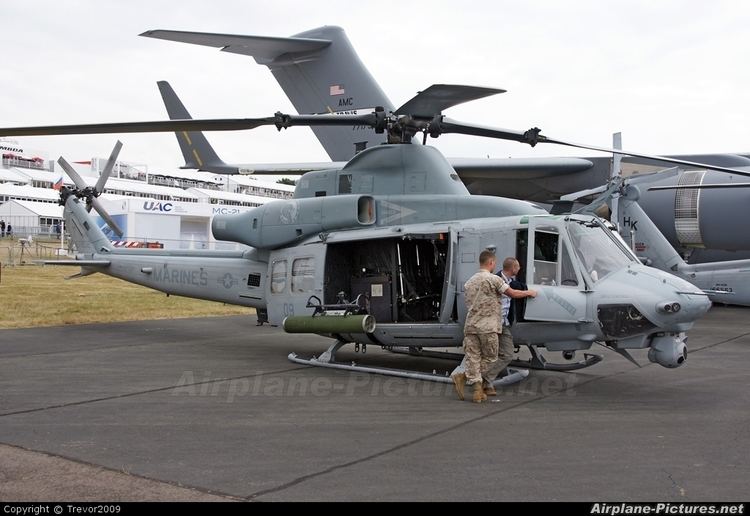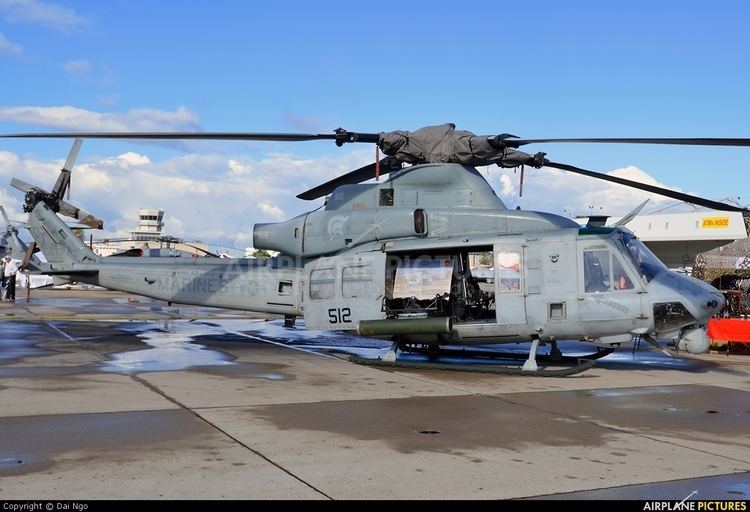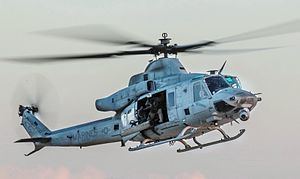Top speed 304 km/h Range 241 km Wingspan 15 m Engine type General Electric T700 | Length 18 m Weight 5,370 kg Unit cost 21,600,000–21,600,000 USD | |
 | ||
The Bell UH-1Y Venom (also called Super Huey) is a twin-engine, medium-sized utility helicopter, built by Bell Helicopter under the H-1 upgrade program of the United States Marine Corps. One of the latest members of the numerous Huey family, the UH-1Y is called also Yankee, from its variant letter.
Contents

After entering service in 2008, the UH-1Y is currently in full-rate production to replace the USMC's aging fleet of UH-1N Twin Huey light utility helicopters, first introduced in the early 1970s. The UH-1Y was to have been remanufactured from UH-1Ns, but in 2005, it was approved for the aircraft to be built as new.

Development

In 1996, the United States Marine Corps launched the H-1 upgrade program by signing a contract with Bell Helicopter for upgrading 100 UH-1Ns into UH-1Ys and upgrading 180 AH-1Ws into AH-1Zs. The H-1 program created completely modernized attack and utility helicopters with considerable design commonality to reduce operating costs. The UH-1Y and AH-1Z share a common tailboom, engines, rotor system, drivetrain, avionics architecture, software, controls and displays for over 84% identical components.

Over the years new avionics and radios, in addition to modern door guns and safety upgrades, have greatly increased the UH-1N's empty weight. With a maximum speed of approximately 100 knots (190 km/h) and an inability to lift much more than its own crew, fuel and ammunition, the UH-1N, while useful, is limited in its utility.

The Y-model upgrades pilot avionics to a glass cockpit, adds further safety modifications and provides the UH-1 with a modern FLIR system. However, the biggest improvement is an increase in engine power. By replacing the engines and the two-bladed rotor system with four composite blades, the Y-model will return the Huey to the utility role for which it was designed. Originally the UH-1Y was to have been remanufactured from UH-1N airframes, but in April 2005 approval was granted to build them as new helicopters.
The Y-model updates an airframe that has been central to the Marine Corps aviation in Iraq. The Huey has many mission requirements including command and control (C2), escort, reconnaissance, troop transport, medical evacuation and close air support. Typically detachments of two to four Hueys have been deployed with detachments of four to eight Cobras. The forward-mounted weaponry of the Cobra combined with the door guns of the Huey provides a 240° field of fire.
Bell delivered two UH-1Ys to the U.S. Marine Corps in February 2008. As of September 2009, the UH-1Y is in full-rate production, with the Marine Corps expected to have 21 by the end of the year. The Marine Corps plans to eventually buy 160 of the Y-models to replace their inventory of N-models, with aircraft deliveries to be completed by 2016.
Design
The UH-1Y variant modernizes the UH-1 design. Its most noticeable upgrade over previous variants is a four-blade, all-composite rotor system designed to withstand up to 23 mm rounds. A 21-inch (530 mm) insert just forward of the main door has been installed for more capacity. The UH-1Y features upgraded engines and transmissions, a digital cockpit with flat panel multifunctional displays, and an 84% parts commonality with the AH-1Z. Compared to the UH-1N, the Y-model has an increased payload, almost 50% greater range, a reduction in vibration, and higher cruise speed.
Operational history
The UH-1Y and AH-1Z completed their developmental testing in early 2006. During the first quarter of 2006 the UH-1Ys were transferred to the Operational Test Unit at the NAS Patuxent River, where they began operational evaluation (OPEVAL) testing. In February 2008, the UH-1Y and AH-1Z began the second and final portion of OPEVAL testing.
On 8 August 2008, the Marine Corps certified the UH-1Y as operationally capable and it was deployed for the first time in January 2009 as part of the aviation combat element of the 13th Marine Expeditionary Unit. The UH-1N Twin Huey was retired by the Marines in August 2014, making the UH-1Y the Marine Corps' standard utility helicopter.
Operators
Specifications
Data from Bell UH-1Y guide, International Directory of Civil Aircraft
General characteristics
Performance
Armament
